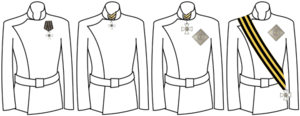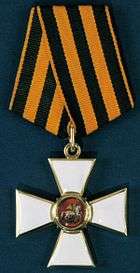Order of St. George
| Order of Saint George | |
|---|---|
|
The Order of Saint George IV class | |
|
Awarded by | |
| Type | Military Order |
| Eligibility | Top and Senior Military Officers |
| Awarded for | Distinction in Combat |
| Status | Active |
| Statistics | |
| Established | November 26, 1769, revived on March 20, 1992[1][2] |
| Precedence | |
| Next (higher) | Order of Saint Andrew |
| Next (lower) | Order For Merit to the Fatherland |
|
Ribbon of the Order of Saint George, first class | |
The Order of Saint George (Russian: Орден «Святого Георгия») is the highest purely military decoration of the Russian Federation. Originally established November 26, 1769 by Empress Catherine the Great[3] it was revived on August 8, 2000 by Decree №1463[2] of the President of Russia. The award criteria were amended on September 7, 2010 by Presidential Decree 1099.[4]
Statute of the Order


The Order of Saint George is awarded to highest and senior military officers for the conduct of military operations to protect the Fatherland from attack by an external enemy which resulted in the complete defeat of the enemy, for the execution of combat and other operations in other states aimed at restoring international peace and security, or for being a model of military science with feats that exemplify military prowess; the Order is also conferred upon officers who were previously awarded state awards of the Russian Federation for distinction in combat.[5]
Description of the Order
The Order of Saint George is divided into four classes, from the First Class to the Fourth class; the highest degree being the Order First class. The four classes are awarded sequentially from the fourth to the first. These four classes are individually identified by the size and manner of wearing the two principal insignia of the Order, the cross and the star.[5]


Cross: A white enamelled cross pattée with a central medallion bearing the image of Saint George on horseback slaying the dragon. The cross measures 60mm across in the case of the Order first class and is worn on a sash in the colours of Saint George (orange and black). The same 60mm cross is worn around the neck on a 45mm wide ribbon also in the colours of Saint George for the Order second class. The cross is 50mm across for the Order third class and is also worn around the neck but from a 24mm wide ribbon in the same colours. The Order fourth class is a 40mm cross worn on the left breast hanging from a pentagonal mount covered with a 24mm wide ribbon of Saint George.[5]
Star: A four-pointed silver gilt star with a gold central medallion bearing the cipher of Saint George "SG" topped by a crown and surrounded by a black enamelled band bearing the motto of the order "For Service and Bravery" ("Za Sluzhbu i Khrabrost"). The star is worn on the left breast for both the Order first and second classes.[5]
Ribbon: The ribbon of the Order of Saint George is orange with three black stripes, commonly called "George's Ribbon". It symbolises fire and gunpowder: the Russian "colors of military glory", and is also thought to be derived from the colours of the original Russian imperial coat of arms (black eagle on a golden background). It was subsequently associated to the colors of the Russian Guard units.[5]
 The ribbon bar for the Order first class is adorned with a miniature golden star.
The ribbon bar for the Order first class is adorned with a miniature golden star. The ribbon bar for the Order second class is adorned with a miniature silver star.
The ribbon bar for the Order second class is adorned with a miniature silver star. The ribbon bar for the Order third class is adorned with a miniature white cross.
The ribbon bar for the Order third class is adorned with a miniature white cross. The ribbon bar for the Order fourth class has no device.
The ribbon bar for the Order fourth class has no device.
Recipients (partial list)
Recipients of the Order second class
- General of the Army Nikolay Yegorovich Makarov[6]
- Colonel General Alexander Zelin[6]
- General of the Army Vladimir Boldyrev[6]
Recipients of the Order fourth class
- Colonel Lambros Katsonis, Greek 18th century revolutionary
- Colonel General Sergei Makarov[6]
- Lieutenant General Vladimir Shamanov[6]
- Lieutenant Colonel Anatoly Lebed[6]
- British Captain Albert Ball, WWI fighter pilot
- Dutch War Correspondent Louis Grondijs, WWI, White Army, Russian Civil War
- Major General Carl Gustaf Emil Mannerheim, Imperial Russia, WWI
- General Pyotr Nikolayevich Wrangel, Imperial Russia, WWI, White Army, Russian Civil War
- Brigadier John Alexander Sinton , Indian Army, WW2
See also
- Cross of Saint George
- Gold Sword for Bravery
- Ribbon of Saint George
- Awards and decorations of the Russian Federation
References
- ↑ Постановление Верховного Совета Российской Федерации от 20 марта 1992 года N0 2557-I
- 1 2 "Decree of the President of the Russian Federation of August 8, 2000 No 1463" (in Russian). Commission under the President of the Russian Federation on state awards. 2000-08-08. Retrieved 2012-02-11.
- ↑ Hurley, C. Russian Orders, Decorations, and Medals Under the Monarchy. Harrison & Sons., Ltd., London. 1935.
- ↑ "Decree of the President of the Russian Federation of September 7, 2010 No 1099" (in Russian). Russian Gazette. 2010-09-07. Retrieved 2012-02-07.
- 1 2 3 4 5 "Statute of the Order of St. George" (in Russian). Commission under the President of the Russian Federation on state awards. 2000-08-08. Retrieved 2012-02-11.
- 1 2 3 4 5 6 "Compiled from the site of the President of the Russian Federation" (in Russian). Kremlin News. Retrieved 2012-02-07.
- ↑ Wikipedia
Further reading
- Voennyĭ orden sviatogo velikomuchenika i pobedonostsa Georgiia: imennye spiski 1769 - 1920; biobibliograficheskiĭ spravochnik / otvetstvennyĭ sostavitel' V. M. Shabanov. Moskva 2004, ISBN 5-89577-059-2
External links
- The Commission on State Awards to the President of the Russian Federation
-
 "Orders of St. George". Catholic Encyclopedia. New York: Robert Appleton Company. 1913.
"Orders of St. George". Catholic Encyclopedia. New York: Robert Appleton Company. 1913.
